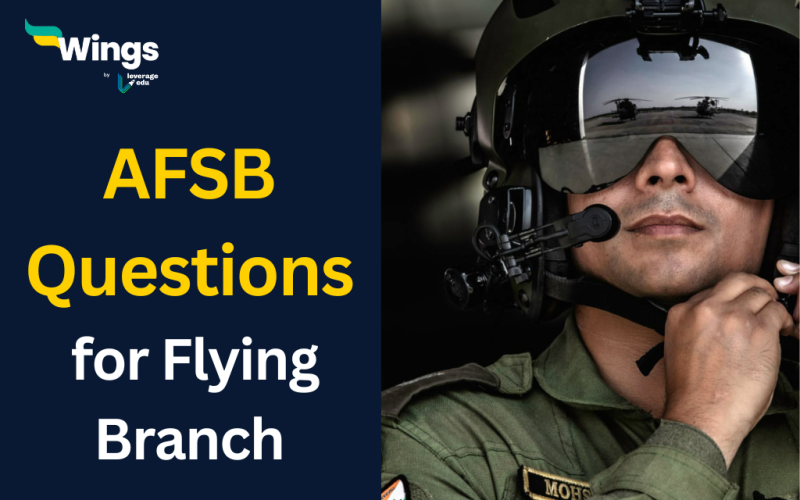Hello, future cadets! I am Maverick the Owl 
Table of Contents [show]
AFSB Tip by Retd. Air Force Officer: The board doesn’t expect you to know everything about flying. However, a little knowledge is always advantageous. If you don’t know anything, calmly say, “I don’t know, sir.”
 AFSB Interview Questions
AFSB Interview Questions
These are some The board will be more impressed if you show enthusiasm for learning. Ask the board to explain any questions you don’t understand.
Ans. According to the Bernoulli principle, A1V1 = A2V2, an increase in a fluid’s speed happens simultaneously with a decrease in its pressure or potential energy. The venture tube is an example.
Ans. Aerodynamics, also known as Bernoulli’s principle, governs how aeroplanes fly. While the engines provide thrust, the pressure differential over and below the wings lifts the craft.
Ans. The force acting on an object that is partially or fully submerged in a fluid is known as buoyancy. A plane needs to move down a mass of air each second equal to its own mass in order to fly. This situation also fits within the buoyancy principle.
Ans. A streamlined shape lowers the friction drag between a fluid, and an object moving through that fluid. This shape is important because it reduces drag to a very high extent.
Ans. A nautical mile per hour is measured iA mile equals 1.6 km/h, and a nautical mile is 1.8 km/h. .6 km/h. Mach is the ratio of the speed of the object to the speed of sound. The speed of the object to the sound speed is expressed as a ratio known as Mach.
Also Read: What is SSB Interview: Screening, Psychological Test, GTO and Interview
Ans. The Boeing C-17 Globemaster is the largest aircraft in the IAF inventory. Before the induction of the C-17, the largest aircraft tag was given to the Illyushin-76, also known as Gajraj.
Ans. Sir, the Air Force has 3 sub-branches of flying: Helicopters, Fighters, and Transport Fleets.
Ans. Sir, a few of the transport aircraft are the C-130J Super Hercules, C-17 Globemaster, Il-76 (Gajraj), AN-32, and Refueler Il-78.
Ans. Sir, a few of the fighter aircraft are the Tejas, Su-30, Mig-29, Mig-21 Bison, and Jaguar.
Ans. Sir, a few of the helicopters are the Mi-17, Mi-35, and ALH Dhruv.
Ans. Sir, most recently, the Air Force has inducted the CASA C-295 as a replacement for AVRO aircraft. Before that, Tejas was inducted into the Air Force. It’s an indigenously made light combat aircraft with the nickname ‘The Flying Daggers’.
Ans. Dakota, aka Parashuram, has been added to the IAF’s vintage fleet. Air Force has also been showcasing it in their 8th Oct flypasts for the last few years.
Ans. An aircraft is a vital component of any air force. Providing air superiority to any country’s military is one of their primary functions. The aircraft of the Indian Air Force serve the same purpose – to defend the country’s borders and fight in wars.
Ans. When not involved in hostilities, the Air Force participates in humanitarian and disaster relief operations, participates in joint training exercises with other militaries, and ultimately prepares for war.
 Questions for NCC Cadets
Questions for NCC Cadets
Ans. A plane can fly comfortably in the stratosphere. There is constant movement of the air below this level, resulting in turbulence.
Ans. Among the trainer aircraft that the IAF operates are Pilatus PC-7s, Hawk HJTs, Kirans, Dorniers, etc.
Ans. It consists of a cockpit, fuselage, wings, undercarriage, stabilisers, aileron, elevators, rudders, etc.
Ans. There is an airspeed indicator, an altimeter, a slip/slip indicator, a compass, and a fuel indicator.
Ans. An aircraft has three basic motions: pitching (as controlled by the elevators), rolling (as controlled by the ailerons) and yawing (as controlled by the rudder).
Ans. A fly-by-wire system replaces an aircraft’s manual flight controls with an electronic interface. Electronic signals are generated by the movement of flight controls. Essentially, it is a digital version of a mechanical flight control system.
Related Posts
| Upcoming Government Exams 2023-24: Monthly Update | |
| How to Join the Indian Air Force | AFCAT Eligibility Criteria: Check Here! |
| CDS Exam Dates 2024 | AFCAT Exam 2024 |
This was all about the “Blog Topic”. For more such informative blogs, check out our Defense Exams Section, or you can learn more about us by visiting our Indian exams page.
 One app for all your study abroad needs
One app for all your study abroad needs












 21+ AFSB Questions for Flying Branch – Find Answers
21+ AFSB Questions for Flying Branch – Find Answers


 Physics Related Question
Physics Related Question  Airforce Related Questions
Airforce Related Questions 45,000+ students trusted us with their dreams. Take the first step today!
45,000+ students trusted us with their dreams. Take the first step today!
